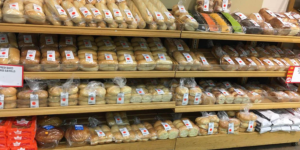Efforts to Extend Shelf Life of Baked Goods an Example of USW’s Commitment

In an example of USW’s commitment to service, it has combined knowledge with experience to extend the shelf life of bakery products. Headline photo: USW Baking Consultant Roy Chung leading a bread baking course at the UFM Baking and Cooking School in Bangkok, Thailand. (Photo courtesy of UFM)
Expanding the window of time breads and cakes remain fresh would help retailers, food distributors and bakers around the world broaden their customer bases and grow their businesses. It would also benefit the U.S. wheat industry, which provides a key ingredient for baked goods in international markets.
But can the window really be expanded? U.S. Wheat Associates (USW) believes it can.
In an example of USW’s commitment to service, the organization’s technical staff and consultants have combined knowledge with experience to extend the shelf life of bakery products. USW has “explored all possibilities” to develop processes and procedures that result in products remaining fresh for days – even weeks – longer than current standards.
Eager to Share the Knowledge
USW, which plans to conduct educational courses late next year or early in 2024 to share what it has learned on the topic, is confident its classrooms will be full.
Most of USW’s work on extending shelf life has been conducted in Southeast Asia, but the lessons learned apply to every bakery across the globe.
“In Southeast Asia, a typical shelf life of bread is seven days, and the maximum shelf life is about 10 days,” explained USW Baking Consultant Roy Chung, who is based in Singapore. “For large bakeries and food distributors, extending it beyond that 10 days would mean they could sell baked goods in towns and villages farther away from their manufacturing base. Retail markets would benefit. Consumers would benefit. Everyone up and down the supply chain would benefit, too.”

USW is planning to conduct educational courses to share what it has learned about extending the shelf life of bread and other baked goods. Lessons taught in the courses will apply to bakeries in every region of the world.
The ‘Squeeze Test’
Shelf life is defined as “the time during which a freshly-manufactured product remains acceptable to the consumer.” Of course, consumers in each region have different tastes and preferences, but the main goal of extending shelf life is universal: The product must pass the “squeeze test.”
The test plays out every day, in every grocery or supermarket. A shopper eases up to a bakery shelf, positions a hand over an unsuspecting loaf of bread and gently squeezes in order to judge the freshness of a prospective purchase.
USW’s work aims to help more loaves and baked goods pass the squeeze test long after leaving a baker’s oven. The result would be more consumers in more places having the ability to purchase the products. That in turn creates more demand for U.S. wheat.
Enemies of Shelf Life
According to Chung, the two major factors that lead to failure in extending shelf life are mold and staling.
“These are separate issues that must be tackled separately, and those are the things we have been working on,” he said. “The mold problem involves things like sanitation, moisture, temperature, relative humidity, water activity and the use of preservatives. The staling problem involves formulation and ingredients selection.”
Tools and formulas in the effort are many, including natural gums and enzymes, sugars and fats, and chemical additives and alternatives to chemical additives. Packaging innovations are being addressed, too, such as packing bread and other baked goods in airtight plastic under a modified atmosphere.
The tools and formulas used are designed to match consumer preferences.
For example, the European market is less accepting of additives. The typical shelf life of a loaf of bread was traditionally one day, but now is 2 to 3 days.
“This is achieved either by using very high-quality wheat such as hard red winter (HRW) or hard red spring (HRS), which have a slower rate of natural staling than some lower-cost wheats,” Peter Lloyd, USW Regional Technical Manager based in Morocco, said. “Our efforts in the European Union and Middle East regions also promotes the use of HRS wheat in bread as a way of getting to cleaner labeling (less additives), a growing issue in that part of the world.”
Longer Shelf Life, Cleaner Labels
The various requirements and preferences in different countries and regions makes the USW effort to extend shelf life of breads and baked goods an ideal subject for baker education.
And a perfect topic for USW’s planned training course and technical support for its overseas customers.
“There are many details involved in achieving the ultimate goal of reaching more consumers with quality bakery products made with U.S. wheat,” said Chung. “We are planning to offer a course that addresses all those details, and from the conversations we have had, there is tremendous interest everywhere.”


